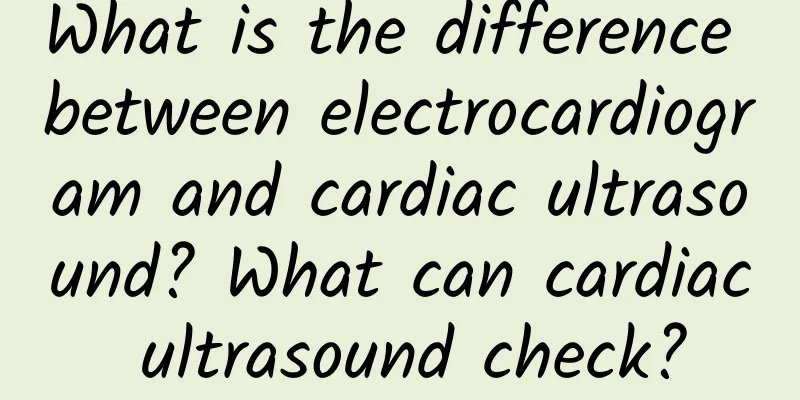What is the difference between electrocardiogram and cardiac ultrasound? What can cardiac ultrasound check?

|
Electrocardiogram and cardiac ultrasound are both examination methods of cardiology, and they are mainly used to check heart problems, such as coronary heart disease, arrhythmia, myocardial ischemia and other diseases. So what is the difference between electrocardiogram and cardiac ultrasound? What can cardiac ultrasound check? What is the difference between an electrocardiogram and a cardiac ultrasound?If the heart is compared to a house, then the electrocardiogram is to check for problems with the house's wiring, and cardiac ultrasound is to check for problems with the doors and windows. An electrocardiogram records the electrical activity of the heart and can detect problems such as arrhythmia, angina pectoris, myocardial infarction, atrial hypertrophy, ventricular hypertrophy, etc. Color Doppler ultrasound of the heart can dynamically observe and record the blood flow velocity of the heart, calculate the ejection fraction, and check whether there are any problems with the heart valves, whether the heart is enlarged, whether there is mitral stenosis or insufficiency, whether there is tricuspid stenosis or insufficiency, whether there is stenosis or insufficiency of the aortic valve and pulmonary valve, whether there is congenital heart disease, and whether there are problems such as atrial septal defect or ventricular septal defect. What can cardiac ultrasound check?Congenital heart diseaseCardiac color Doppler ultrasound can show almost all heart malformations, such as common septal defects, patent foramen ovale, outflow tract stenosis, tetralogy of Fallot, patent ductus arteriosus, etc. Cardiac color Doppler ultrasound can show unclosed defects and shunt blood flow, valvular stenosis or insufficiency, valvular malformation, etc. It is the preferred method for screening congenital heart disease. Acquired changes in cardiac structureIf it is not a congenital heart disease, but a change in the heart structure caused by acquired factors, it can still be observed through cardiac ultrasound. For example, we can see the changes in the heart structure, size, valves, thickness, etc., as well as the resulting changes in blood flow, and accurately measure the changes in the heart's atria, ventricles, valves, etc. Effective assessment of cardiac functionCardiac color ultrasound can intuitively show the heart's contractile function, ventricular wall motion analysis, coordination, etc., and can calculate ratios such as cardiac output per stroke, thereby effectively evaluating heart function, which cannot be replaced by other related examinations. To understand whether there are any abnormalities in the tissues adjacent to the heartThe presence or absence of pericardial effusion, pericardial calcification, the ascending and descending aorta, the superior and inferior vena cava, etc. are commonly used examination tools to understand the condition of the tissues adjacent to the heart. Evaluating the effectiveness of heart disease treatmentCardiac ultrasound can also be used to determine treatment direction, treatment method, treatment effect, etc. It is also an indispensable examination method for cardiologists. Common electrocardiogram examination methodsThe first one is the ordinary electrocardiogram (ECG) that everyone is most familiar with. ECG is relatively simple to operate and very fast, usually completing in 2-3 minutes. In most cases, it can make a clear diagnosis for patients with obvious arrhythmias and myocardial ischemia (which can be understood as a manifestation of coronary heart disease). In clinical practice, some patients' symptoms are not very obvious, such as intermittent arrhythmias, or myocardial ischemia in patients with mild coronary heart disease is not very obvious. In this case, ECG may miss the diagnosis and be biased. Fortunately, we still have a weapon, that is, Holter monitoring. Similar to dynamic blood pressure monitoring, Holter also needs to be worn on the body for 24 hours. The difference is that it is constantly performing heart monitoring that you cannot perceive. During this time, it will quietly record your heart rate, heart rhythm, and the blood supply and flow of the heart, and then conduct a more complete analysis through the doctor's interpretation. |
<<: Can diabetes be controlled without medication? Why do diabetics feel tired?
>>: Is arrhythmia dangerous? What are the dangers of sinus arrhythmia on electrocardiogram?
Recommend
What should women eat to enlarge their breasts during menstruation?
Many girls hope to have a pair of proud breasts. ...
Bleeding after hysteroscopy
Hysteroscopic surgery is a common gynecological s...
Suffering from eye disease but not receiving treatment for a long time due to poverty, the "Glaucomania" charity fund helps glaucoma patients retain their sight
"Where there is light, there is hope." ...
What is the cause of a pimple near the vagina?
Women's health issues have always been the un...
What should I eat when I have back pain during menstruation?
In daily life, back pain during menstruation is a...
When will menstruation resume after induced abortion?
Some women may have to undergo induced abortion d...
Why does the cactus rot? What should I do if the cactus roots are rotten so that they can take root?
Cactus and cactus are plants that originally grew...
How does it feel to be pregnant?
When some people see someone around them pregnant...
4 million people died prematurely! How can cooking at home still cause serious pollution?
A study recently published in International Envir...
What is the best sleeping position during pregnancy?
Many women pay special attention to their sleepin...
Pain in left triangle area
The female triangle is a relatively sensitive are...
Vulvar itching, leucorrhea with odor
When it comes to women's facial care, cleanli...
How to nourish kidney for women
What methods should women choose to nourish their...
Vulvar itching with white skin
Vulvar itching with white skin is a common female...
What is the reason why the early pregnancy test paper can not detect?
Pregnancy is definitely a joyful thing for a woma...









